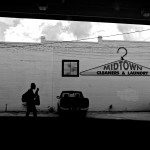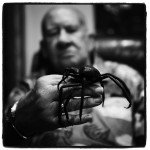+ By Leah Weiss + Photos by Jeffrey Pratt Gordon
Jeffrey Pratt Gordon’s apartment got him his first job in the movie industry. It was a loft above Baltimore’s original Daily Grind coffeehouse, where he’d been earning meager wages. One look at the environment—a self-made world full of original artwork and antiques—and Vincent Peranio, John Waters’ production designer, said, “You got it, kid.”
“It” was working in the prop department for Waters’ 1994 film Serial Mom. Gordon had sent a letter of interest to Peranio, who interviewed him over brunch and then asked to see his apartment. Gordon took joy in learning the craft, and then propelled himself into the belly of the movie beast.
 Gordon’s trajectory from Annapolis High School graduate to prop master, production designer, screenwriter, actor, and producer has been anything but straight. It twists and turns as he seeks creative inspiration from anywhere and everywhere. Whenever a new idea or whimsy grabs him, he shares it with his wife, whose usual supportive response is, “Shut up and do it.”
Gordon’s trajectory from Annapolis High School graduate to prop master, production designer, screenwriter, actor, and producer has been anything but straight. It twists and turns as he seeks creative inspiration from anywhere and everywhere. Whenever a new idea or whimsy grabs him, he shares it with his wife, whose usual supportive response is, “Shut up and do it.”
Growing up, Gordon was surrounded by creativity. His grandfather was a collector and wood carver, his mother painted, and his father—who was in the Navy—was a photographer. Moving frequently, Gordon observed the world around him. “Being the new kid teaches you a lot,” he says. “Every city has a different vibe, a different personality. You’re constantly having to adapt to understand, fit in, rebel.” He constantly rearranged his room, perhaps mirroring the force of change in his life. It’s something he still does.
In the early 1980s, Gordon’s family settled in Annapolis. After stumbling across a cassette tape of punk rock music, he became enthralled with punk expression. That these artists were doing whatever they wanted to do, carving out a space for themselves in abandoned buildings, resonated with him. He found his way into the scene by photographing bands (he would meet his future wife at a Bad Brains show in DC), and went on to study photography and art history, receiving a double bachelor of fine arts from University of Maryland, Baltimore County.
After working props on Serial Mom, Gordon went with the crew to Homicide: Life on the Street, where he worked for seven years. During the show’s three-month production hiatus, he worked on feature films. This led to other television series, including David Simon’s The Corner and The Wire, and films such as Wedding Crashers, Syriana, National Treasure, Head of State, and Ladder 49.
 He became a prop master and eventually an on-set dresser, ensuring that the artistic vision translated on camera. He then rose to his current position as a production designer. “You go from the written word to stage direction, visualizing the set’s look and feel and presenting it to the director and studio,” he says. It’s based on a series of creative, collaborative conversations with the director, show runner, and actors. “I like distilling an idea to the essence of what it should be, and a week later, it’s built and people are standing inside of what was originally in my head.” It’s also chaotic and intense: “I always get really nervous when I deliver a set for the first time, just hoping that it works for everybody.”
He became a prop master and eventually an on-set dresser, ensuring that the artistic vision translated on camera. He then rose to his current position as a production designer. “You go from the written word to stage direction, visualizing the set’s look and feel and presenting it to the director and studio,” he says. It’s based on a series of creative, collaborative conversations with the director, show runner, and actors. “I like distilling an idea to the essence of what it should be, and a week later, it’s built and people are standing inside of what was originally in my head.” It’s also chaotic and intense: “I always get really nervous when I deliver a set for the first time, just hoping that it works for everybody.”
While at home, caring for his newborn daughter, Gordon collaborated with fellow set dresser Jeff Stacy on a screenplay. Seven years later, Gospel Hill, starring Danny Glover and Angela Bassett, was showing in theatres. “Here we are, these Podunk little crew guys, writing and producing a feature film,” he chuckles.
When he felt the pull to act, he auditioned and landed roles. While playing the role of Johnny “Fifty” in The Wire, he split his workweek between acting and crewing. “It was a six month head-spin, but I loved it,” he says.
Notwithstanding his screenwriter, actor, and producer status, Gordon stays grounded in set work, a choice that perplexes some. Once, while working in the greens department on Night at the Museum, a fellow crew member who saw Gordon planting shrubs asked, “You’re a big-time screen writer, why are you slummin’ with the crew?” His answer: “Because I love what I do.”
 One of Gordon’s muses is Johnny Eck. Born in 1911, Eck lived in Baltimore, and although he had a truncated torso—he was 18 inches tall—he had an active life as an artist, sideshow performer, and Renaissance man. “During his 79 years, he did more than most people did with two legs,” says Gordon. “If you have that fire inside, you can do it.” Gordon acquired much of Eck’s estate, created an online Eck museum, and curated an exhibit for Maryland Institute College of Art.
One of Gordon’s muses is Johnny Eck. Born in 1911, Eck lived in Baltimore, and although he had a truncated torso—he was 18 inches tall—he had an active life as an artist, sideshow performer, and Renaissance man. “During his 79 years, he did more than most people did with two legs,” says Gordon. “If you have that fire inside, you can do it.” Gordon acquired much of Eck’s estate, created an online Eck museum, and curated an exhibit for Maryland Institute College of Art.
Based in Baltimore, Gordon spends time in Atlanta, working as a production designer on several television series and feature films. He is co-writing, shooting, and producing a documentary about the late Rolling Stones saxophonist Bobby Keys, developing a television series based on Baltimore novelist Justin Sirois’ books, So Say the Waiters, and continuing work on his Johnny Eck documentary. He also stays busy with his wife of 15 years, raising their nine-year-old daughter, traveling as much as possible, and photographing the world around him.
For Gordon, life is about going on tangents. “I would kill myself if I had to work in a cubicle,” he says. “I’ve got too many ideas and too much to say and do. Drive is about creativity, however it manifests itself, and I want to be in the center of it.” After twenty-three years, he values being able to find his way kindly. “A good day is a day when you have learned something and have been able to teach somebody something.” █




















